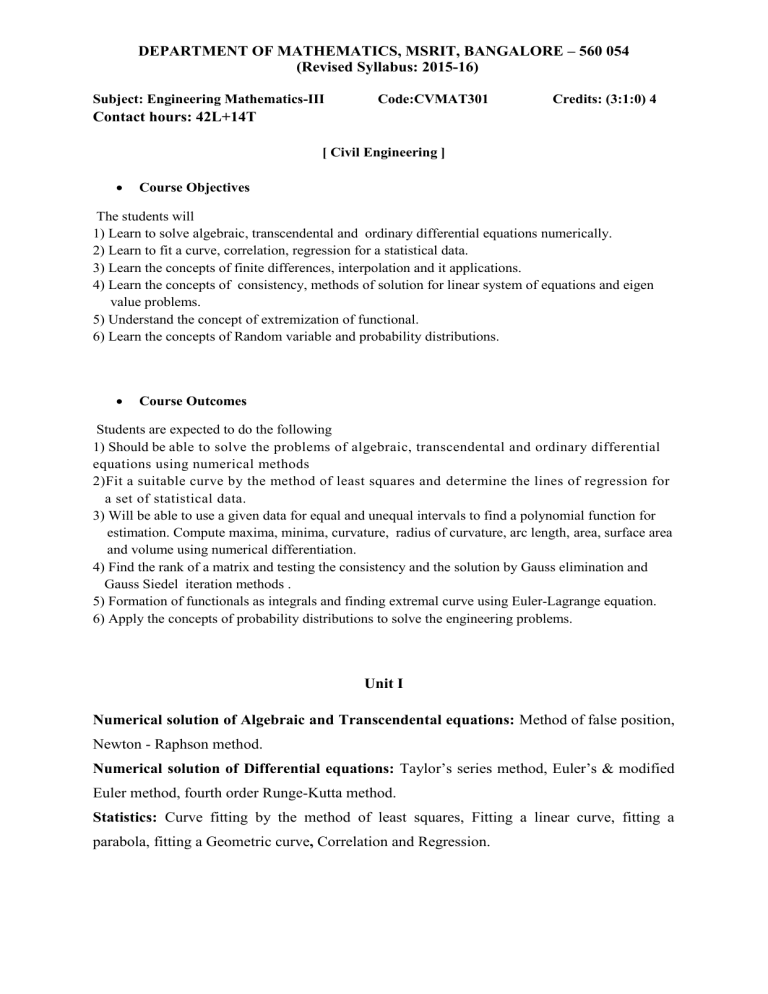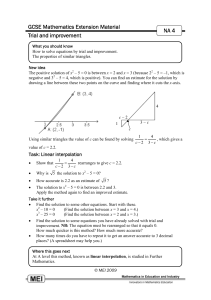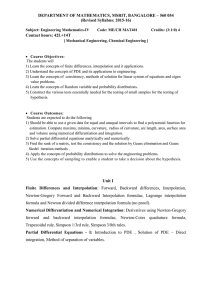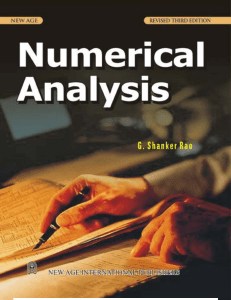DEPARTMENT OF MATHEMATICS, MSRIT, BANGALORE – 560 054 (Revised Syllabus: 2015-16)

DEPARTMENT OF MATHEMATICS, MSRIT, BANGALORE – 560 054
(Revised Syllabus: 2015-16)
Subject: Engineering Mathematics-III Code:CVMAT301 Credits: (3:1:0) 4
Contact hours: 42L+14T
[ Civil Engineering ]
Course Objectives
The students will
1) Learn to solve algebraic, transcendental and ordinary differential equations numerically.
2) Learn to fit a curve, correlation, regression for a statistical data.
3) Learn the concepts of finite differences, interpolation and it applications.
4) Learn the concepts of consistency, methods of solution for linear system of equations and eigen value problems.
5) Understand the concept of extremization of functional.
6) Learn the concepts of Random variable and probability distributions.
Course Outcomes
Students are expected to do the following
1) Should be able to solve the problems of algebraic, transcendental and ordinary differential equations using numerical methods
2)Fit a suitable curve by the method of least squares and determine the lines of regression for
a set of statistical data.
3) Will be able to use a given data for equal and unequal intervals to find a polynomial function for
estimation. Compute maxima, minima, curvature, radius of curvature, arc length, area, surface area
and volume using numerical differentiation.
4) Find the rank of a matrix and testing the consistency and the solution by Gauss elimination and
Gauss Siedel iteration methods .
5) Formation of functionals as integrals and finding extremal curve using Euler-Lagrange equation.
6) Apply the concepts of probability distributions to solve the engineering problems.
Unit I
Numerical solution of Algebraic and Transcendental equations: Method of false position,
Newton - Raphson method.
Numerical solution of Differential equations:
Taylor’s series method, Euler’s & modified
Euler method, fourth order Runge-Kutta method.
Statistics: Curve fitting by the method of least squares, Fitting a linear curve, fitting a parabola, fitting a Geometric curve , Correlation and Regression.
Unit II
Finite differences and interpolation : Forward and backward differences, Interpolation,
Newton –Gregory forward and backward interpolation formulae, Lagrange’s interpolation formula, Newton’s divided difference interpolation formula (no proof).
Numerical differentiation and Numerical Integration : Derivatives using Newton-Gregory forward and backward interpolation formulae, Newton - Cote’s quadrature formula,
Trapezoidal rule, Simpson’s (1/3)rd rule, Simpson’s (3/8)th rule.
Unit - III
Linear Algebra: Elementary transformations on a matrix, Echelon form of a matrix, rank of a matrix, Consistency of system of linear equations, Gauss elimination and Gauss – Seidal method to solve system of linear equations, eigen values and eigen vectors of a matrix,
Rayleigh power method to determine the dominant eigen value of a matrix, diagonalization of a matrix, system of ODEs as matrix differential equations. Quadratic forms.
Unit IV
Calculus of variation: Variation of a function and a functional, Extremal of a functional,
Euler’s equation, Standard variational problems, Geodesics, Minimal surface of revolution,
Hanging cable and Brachistochrone problems.
Unit V
Random Variables: Random Variables (Discrete and Continuous), Probability density function, Cumulative density function, Mean, Variance, Moment generating function.
Probability Distributions: Binomial and Poisson distributions, Normal distribution,
Exponential distribution, Uniform distribution.
Text Books:
1.
Erwin Kreyszig – Advanced Engineering Mathematics – Wiley publication – 10 th edition-2015.
2.
B.S.Grewal - Higher Engineering Mathematics - Khanna Publishers – 43 rd
edition-
2014.
References:
1.
Glyn James – Advanced Modern Engineering Mathematics – Pearson Education – 4 th
– 2010.
edition
2.
Murray R. Spiegel, John Schiller & R. Alu Srinivasan - Probability & Statistics - Schaum’s outlines -2 nd edition - 2007.


